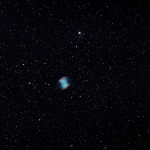Messier 2 taken on 5 July 2013 from Copper Breaks State Park outside of Vernon, Texas. Shot with a Celestron Edge HD 8″ Schmidt-Cassegrain mounted on a Celestron Advanced VX.
60 subframes of 60 seconds unguided


Messier 27, the Dumbbell Nebula, taken from suburban Dallas on a night with 80% – 90% humidity with the object in the light dome of a massive shopping complex just a mile away. Yes, you can practice astrophotography in the city! This image was built from 41 minutes worth of 60 second sub-exposures stacked one on top of the other with some other frames to subtract various forms of noise.
At an average estimated distance of 1,250 light years this planetary nebula is relatively close. Several thousand years ago the parent start ejected its coronal mass and collapsed into the white dwarf in the center of the nebula. This is the same fate our star will have some 6 billion years from now. M27 has a visual brightness of magnitude 7.4 which makes it visible as a grey hourglass shape in small (80mm refractors, 114mm reflectors) telescopes at moderate magnifications. The central star itself does not emit very much visible light so what we’re seeing is gasses that are excited by infrared or x-ray radiation. Hydrogen Alpha glows red and doubly ionized Oxygen (O-III) glows green. These colors aren’t detectable by the human eye but through the magic of technology we can pull that color out.
OK, I have heard many times about BackyardEOS for controlling Canon EOS cameras used in Astrophotography. Unfortunately my 1st generation Digital Rebel (300D) with its now ancient DIGIC-I processor is not a supported platform. Even though it does have USB and you can trigger the shutter through that you can only use the predefined exposure lengths up to 30 seconds. You cannot use Bulb mode through the USB port, only through the 2.5mm phono plug. The 300D only has USB 1.1 so even if you could hold the shutter open indefinitely, downloading a full raw image would take an age. Added functionality in the DIGIC-II and greater processors includes things like sub-frames and live view which lets you do lovely things like live preview for frame and focus. I didn’t realize how incredibly useful that was until I borrowed my mom’s 1100D and tried BackyardEOS out for myself. Let me tell you, that is WONDERFUL. I didn’t get to experiment with the drift alignment routine in BYEOS but if it is even as simple as the parallel crosshair it is a useful tool indeed. BackyardEOS is a complete bargain for $30, $38 if you want to use ASCOM to control the focuser. What’s that ASCOM plugin all about? Well, if you have an ASCOM compliant focuser and the appropriate drivers on your PC, BYEOS can do all the FWHM auto-focus thing for you so all you do is find a nice star to focus on and press GO! Then magic happens and your image is focused for you. Fan-frickin-tastic! Great stuff that BYEOS

Shot from the backyard in Allen, TX on 2013-01-20 @ 2300 CST. The seeing was pretty darn good, humidity was high as was the light pollution but it was bearable for my first time seriously out with the scope in a while. Camera control was through BackyardEOS which I’ve decided is the bee’s knees. If you have a Canon camera that has USB 2.0 on it, check this lovely bit of software out. Well worth the $30, $38 if you have an ASCOM focuser and want BYE to autofocus for you.

M42/M43 (Great Orion Nebula)
15 x 30 seconds
30 x 120 seconds
Borrowed Canon T3 (Thanks Mom!)
Meade LXD75/SN6
Baader IDAS-LPS
Baader MPCC
After seemingly unending weeks of temperatures over 100F during the day and 85F at night with at least 60% humidity we get some relief. It came in the form of Tropical Storm Lee which pummeled the East Coast with rain for days on end once again flooding large portions of Tennessee but the break in temperatures is very welcome here in North Texas. The moon is about 75% full so deep sky photography will be challenging but I took some pictures of the moon, just in case. At least the night won’t be a total loss now even if everything goes completely pair shaped. Currently the temperatures are in the middle 70’s and the humidity is in the upper teens to lower 20’s with calm winds. Only barely enough gust to keep the air from being completely still. Currently the SN6 is trained on M27 and snapping away happily after a small amount of minor drama. I took my time getting set up but I bumped the tripod lightly with my foot while aligning the mount. Hopefully no ill will come of that. We shall see in the morning.
It’s been oppressively hot here in Tejas recently but I’m starting to get the itch to play under the stars once more. I needed to give my declination axis a tune so I did that last week hoping to use it when it was actually looking like it might get into the 70’s overnight. Granted it wasn’t much into the 70’s with lows forecast at 78F and 79F but it was less than 80F at least. I just got a Clear Sky Alarm Clock notification that the sky is favorable tonight so I may ponder this over dinner.